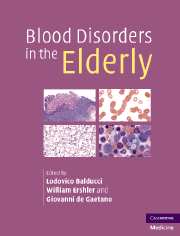Book contents
- Frontmatter
- Contents
- List of contributors
- Preface
- Part I Epidemiology
- Part II Hematopoiesis
- Part III Anemia of aging
- 12 Erythropoietin and aging
- 13 Iron and aging
- 14 Prevalence and mechanisms of B12 deficiency
- 15 Consequences of chronic anemia in the older person
- 16 The pathogenesis of late-life anemia
- 17 Treatment of late-life anemia
- Part IV Hematologic malignancies and aging
- Part V Disorders of hemostasis in the elderly
- Index
13 - Iron and aging
from Part III - Anemia of aging
Published online by Cambridge University Press: 21 October 2009
- Frontmatter
- Contents
- List of contributors
- Preface
- Part I Epidemiology
- Part II Hematopoiesis
- Part III Anemia of aging
- 12 Erythropoietin and aging
- 13 Iron and aging
- 14 Prevalence and mechanisms of B12 deficiency
- 15 Consequences of chronic anemia in the older person
- 16 The pathogenesis of late-life anemia
- 17 Treatment of late-life anemia
- Part IV Hematologic malignancies and aging
- Part V Disorders of hemostasis in the elderly
- Index
Summary
Iron is an essential trace element
Iron is required by almost all living organisms. In mammals, iron is a component of heme in oxygen-transporting and storage proteins (hemoglobin and myoglobin), and a component of heme or iron–sulfur clusters in many redox enzymes, including enzymes of the mitochondrial respiratory chain and the ribonucleotide reductase, involved in deoxyribonucleotide synthesis. As these enzymes have a vital role in cell proliferation and cell viability, iron deficiency results in inhibition of cell proliferation and eventually in cell death. On a systemic level, mild iron deficiency can produce subtle deficits in endurance, work capacity, and possibly neuropsychological performance. More severe iron deficits cause iron deficiency anemia, which impairs oxygen delivery to tissues and has adverse effects on cardiopulmonary function.
In response to infection, humans and animals sequester iron into iron-binding proteins (e.g., lactoferrin, siderocalin) and locations less accessible to most invading microbes (cytoplasm of macrophages and hepatocytes). This is an important innate host defense mechanism, as most microbes require iron for their growth. However, this response also impairs the delivery of iron to the nascent erythrocytes in the bone marrow and results in anemia of inflammation (anemia of chronic disease). Although anemia of inflammation is usually mild to moderate, it too can exacerbate concurrent cardiopulmonary deficits.
- Type
- Chapter
- Information
- Blood Disorders in the Elderly , pp. 171 - 180Publisher: Cambridge University PressPrint publication year: 2007

